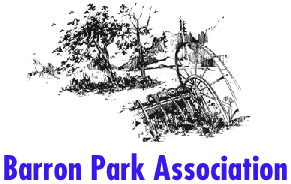Emergency Preparedness
By Patrick Muffler
Types of disasters
Why should residents of Barron Park take the time to learn about
emergency preparedness and spend the money to become prepared? The
simple answer is that there are four major types of disasters that
could seriously affect our community: earthquakes, floods, toxic
spills and terrorism.
Earthquakes
Most of us are aware that we live in "Earthquake Country", and almost
all of us have felt the small earthquakes that jolt the Bay Area
every few months. Some of us remember the 1989 magnitude 6.9 (M=6.9)
Loma Prieta earthquake located in the Santa Cruz Mountains, although
Barron Park was spared the major damage that affected the Santa Cruz
Mountains and parts of San Francisco and Oakland. Few of us, however,
have ever experienced a large earthquake (M> 6.7) on one of the major
faults that criss-cross the Bay Area. The U.S. Geological Survey
estimates that there is a 70% chance of at least one magnitude 6.7 or
greater earthquake striking the San Francisco Bay region between 2000
and 2030 (USGS Fact Sheet 152-99; see http://quake.usgs.gov/). Such
an earthquake, regardless of its exact location, would cause major
damage throughout the Bay Area. Keep in mind that the 1995 M=6.9
earthquake in Kobe, Japan, a bayside urban area not unlike the San
Francisco Bay Area, killed 6,000 people and caused over $100 billion
in damage!
Floods
Many of us have had first-hand experience with floods in Barron Park,
in particular the 1983 floods from Matadero and Barron Creeks. Maps
prepared by Doug Graham show that 90 acres, or about 20% of Barron
Park was affected by this flooding — and this was only a
"20-year" flood. Although subsequent work by the Santa Clara Valley
Water District has greatly improved the situation, there are still
certain scenarios that could cause this community disaster to be
repeated.
Toxic spills
Barron Park is located next to a light industrial area with a low but
real possibility of toxic spills. In addition, nearby transportation
arteries provide potential sources of toxic spills.
Terrorism
Finally, the events of 11 September 2001 shocked us into the
realization that terrorist attacks are a real possibility, albeit
inherently unpredictable in space, time and nature. Guidelines for
preparedness and response are only now being prepared by the Federal
Government.
Emergency Preparedness in Barron Park
Emergency preparedness in a community like Barron Park takes two
forms: (1) community preparedness, and (2) household preparedness.
Neither alone is sufficient.
Community preparedness is represented by the activities of
organizations such as the Barron Park Emergency Preparedness
Committee ()
and the Palo Alto Office of Emergency Services. Activities fall under
the general categories of education, inventory of emergency
equipment, and emergency response training. Palo Alto has an
excellent training program (PANDA) to provide a cadre of trained
individuals to supplement and support the Palo Alto Fire Department,
whose resources will be overwhelmed in a major disaster, and whose
efforts of necessity must be directed towards facilities of highest
priority (e.g., hospitals). The Barron Park Association has been a
leader in preparedness education, having worked closely with the City
of Palo Alto in the preparation of "Living with our Faults—an
Earthquake Preparation guide."
Household preparedness boils down to the ability of each household to
provide for its basic needs for at least several days to a week,
without any assistance from an outside government or private entity.
In a major disaster, each household will be on its own. We can
anticipate disrupted water supplies (remember that the Hetch Hetchy
water pipeline crosses right over the Hayward Fault!), absence of
electricity and gas, and perhaps significant structural damage to our
dwellings. We all need to have sufficient emergency supplies to tide
us over the period until outside assistance becomes available and
utilities are restored.
The essentials of any cache of emergency supplies are water, food, a
battery powered radio and first-aid supplies. Excellent guidelines
for emergency caches are presented in the 3rd edition of "Living with
our Faults", published in 1994 by the City of Palo Alto— (see table of contents). For those who choose not to build their own
emergency caches, the American Red Cross sells a wide selection of
Disaster Preparedness Kits that are described in detail at .
How well are we prepared?
Some Barron Park households are well-prepared, but most are poorly
aware of the potential disasters and consequently are ill-prepared.
Although precise statistics are lacking, perhaps 80% of our
households fall in the unprepared category. In the case of a major
emergency, what will this 80% do for the basics of existence? For the
first week after a disaster, none of us can expect any help from
government agencies, utilities or other outside entities. If those
who are unprepared depend on the good will of their prepared
neighbors, their neighbors' preparedness is reduced from one week to
just a day or two, and then everyone is in trouble.
Hence, the major goal of the Barron Park Association and its
Emergency Preparedness Committee is to greatly increase the
percentage of households prepared for a disaster. The first step is
an awareness of our vulnerability. The second is each household
taking some simple steps to assure adequate supplies of emergency
water, food, etc. for a week without assistance.
To this end, we strongly encourage you to fill out and return the
form provided in this newsletter. This will achieve two things: (1)
provide the Barron Park Association with a better inventory of the
resources available in an emergency, and (2) encourage you to think
about the steps each individual household should take to prepare for
the disaster that someday surely will strike Barron Park. The on-line
form is at .

